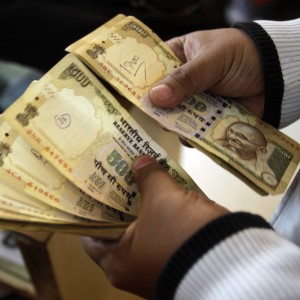Indian rupee hits new record low, stocks dive

An Indian customer counts Indian rupee notes at a foreign currency exchange shop in Bangalore, India, on Aug. 20, 2013. The rupee plunged to a new low, posting one of its sharpest-ever single-day falls, and shares tumbled Tuesday, Aug. 28, on fears about the impact of massive new food subsidies on already strained finances. AP PHOTO/AIJAZ RAHI
MUMBAI—India’s rupee plunged to a new low, posting one of its sharpest-ever single-day falls, and shares tumbled Tuesday on fears about the impact of massive new food subsidies on already strained finances.
Asian shares and currencies were also hit on worries about possible US military intervention in Syria, raising fears of a spurt in oil prices.
The rupee, one of Asia’s worst-performing currencies this year, fell to a lifetime low of 66.30 rupees to the dollar, slipping past its previous low of 65.56 last Thursday.
Tuesday saw the rupee post one of its sharpest single-day falls, plummeting 3 percent in value to end Tuesday at 66.24, from Monday’s close of 64.31.
The RBI (Reserve Bank of India) is suspected to have sold dollars at 65.90 levels, but it failed to prop up the rupee, said a dealer with a forex firm.
“Whatever the RBI is doing is not enough. We can expect more historic lows in coming weeks,” said Param Sarma, chief executive with consultancy firm NSP Forex.
The benchmark Sensex index plunged 3.18 percent to close at 17,968.08 points, while local prices of gold, considered a safer investment, rose.
The food bill, which economists say would strain government finances due to its annual cost of around $19 billion, comes at a time of decade-low economic growth of around five percent.
The bill, a flagship program of the ruling Congress party passed by parliament’s lower house Monday, is intended to end endemic hunger and malnutrition in the aspiring superpower.
Finance Minister P. Chidambaram insisted at a news conference in New Delhi that India can finance the bill and still cut its record current account deficit—the broadest measure of trade—whose level has unnerved investors.
“We have done our sums—there is enough money to provide for the food security bill” and meet the deficit target, “which is a red line that will not be breached,” Chidambaram said.
He said the rupee was now undervalued and India would have to be “patient, be firm—do whatever is required to be done—and the rupee will find its appropriate level.”
The bill is designed to provide food grains to nearly 70 percent of the population, or 800 million people, for as little as one rupee per kilogram.
The central bank earlier warned that increased public spending on the bill could deepen the deficit and fuel already high inflation.
The rupee, like other emerging-market currencies, has also fallen on fears of foreign fund outflows as the US economy recovers and the US Federal Reserve rolls back its massive stimulus program.—Salil Panchal
